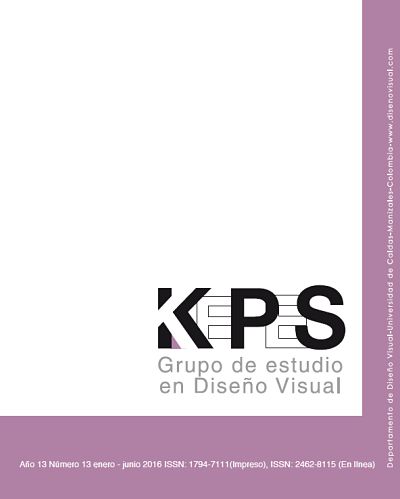Authors
Abstract
The role of the method in the production of knowledge in the field of design is analyzed. This analysis is done by comparing, in different authors, the various concepts of project activity and the implications in its practice. The method plays a role in clarifying the project phenomenon. A more specific view is obtained, this is to say, the method proceeds from a rational guidance to be considered an interpretive guide within the design process. The hermeneutical perspective is incorporated as the most appropriate to articulate the kind of rationality applied to the design and contextualization of its results.
Keywords
References
Archer, B. (1968). Systematic Method for Designers. London. Royal College of Art.
Armatte, M. (2006). La noción de modelo en las ciencias sociales. Empiria. Revista de metodología de ciencias sociales, (11), 33-70.
Purcell AT. and Gero J. S..(1998). Drawings and the design process. Design studies, 19, 389-430.
Banach, S. J., & Ryan, A. (2009). The art of design: A design methodology. Military review, 2009, 105-115.
Bamford, G. (2002). From analysis/synthesis to conjecture/analysis: a review of Karl Popper’s influence on design methodology in architecture. Design Studies, 23(3), 245-261.
Baur, R. (2008). Diseño Global y Diseño Contextual. En Historia del Diseño en América Latina y el Caribe (232-237). Brasil: Blücher.
Buchanan, R. (1992). Wicked problems in design thinking. Design issues, 8(2), 5-21.
Bürdeck, B. (2002). Diseño. Historia, teoría y práctica del diseño industrial. España: Gustavo Gili.
Coyne, R. (2005). Wicked problems revisited. Design studies, 26(1), 5-17.
Crilly, N., Maier, A. M., & Clarkson, P. J. (2008). Representing artefacts as media:Modelling the relationship between designer intent and consumer experience. International Journal of Design, 2(3), 15-27.
Cross, N. (2002). Métodos de Diseño. Estrategias para el diseño de productos. México: Limusa Wiley.
Csikszentmihalyi, M. (1999). Implications of a Systems Perspective for the Study of Creativity. In R. J. Sternberg (Ed.), Creativity Handbook. Cambridge: Cambridge University Press.
Dussel, E. (1990). Filosofía de la Producción. Bogotá: Nueva América.
Farrell, R., & Hooker, C. (2013). Design, science and wicked problems. Design Studies, 34(6), 681-705.
Ferreyra, A (2011). De C.I. Lewis a Alain Badiou en torno al concepto de Modelo. VIII Jornadas de Investigación en Filosofía. Universidad Nacional de La Plata. Facultad de Humanidades y Ciencias de la Educación. Departamento de Filosofía, La Plata.
Gibbons, M. et al. (1997). La nueva producción de conocimiento. Barcelona, España: Pomares-Corredor S.A.
González Ochoa, C. (s/f) Hermenéutica y Antropología. Citado con la autorización del autor.
González R, G. (1994). Estudio de Diseño. Sobre la construcción de las ideas y su aplicación a la realidad. Buenos Aires: Emecé Editores.
González, W. J. (2007). Las ciencias de diseño: racionalidad limitada, predicción y prescripción. Netbiblo.
Hernández, F. (2006) “Campos, temas y metodologías para la investigación relacionada con las artes “en Gómez, M., Hernández F., y Pérez, H. C. Bases para un debate sobre investigación artística. Madrid, Ministerio de Educación y Ciencia, pp- 681 – 713.
Jahnke, M. (2012). Revisiting design as a hermeneutic practice: An investigation of Paul Ricoeur’s critical hermeneutics. Design Issues, 28(2), 30-40.
Kroes, P. (2002). Design methodology and the nature of technical artefacts. Design studies, 23(3), 287-302.
Llovet, J. (1981). Ideología y metodología del diseño. Barcelona: Ed. Gustavo Gili.
Malinowski, B. (1931): “Culture”, en Encyclopaedia of the Social Sciences, t. 4, New York, [The Ber- wich and Smith Co.].
Malinowski, B. (1968): Une théorie scientifique de la culture (Versión francesa), París, Maspero.
Ritter, H. Webber, M. (1974). Problemas Perversos. En Contra un diseño dependiente (221-230). México: Universidad Autónoma Metropolitana - Azc.
Rodríguez M, Luis. 1990. Para una teoría del diseño. México, México. Tilde.
Sevaldson, B. (2010) “Discussions & Movements in Design Research”, en FORMakademisk, vol. 3, núm. 1, pp. 8 – 35.
Simon. H. (1969). The Sciences of the Artificial. Cambridge: MIT press.
Siu, K. W. M. (2003). Users’ creative responses and designers’ roles. Design Issues, 19(2), 64-73.
Snodgrass, A., & Coyne, R. (1996). Is designing hermeneutical? Architectural Theory Review, 2(1), 65-97.
Snodgrass, A., & Coyne, R. (1992). Models, metaphors and the hermeneutics of designing. Design Issues, 9(1), 56-74.
Suwa, M., Purcell, T., & Gero, J. (1998). Macroscopic analysis of design processes based on a scheme for coding designers’ cognitive actions. Design studies, 19(4), 455-483.
Van Aken, J. E. (2005). Valid knowledge for the professional design of large and complex design processes. DesignStudies, 26(4), 379-404.

 PDF (Español)
PDF (Español)
 FLIP
FLIP





















